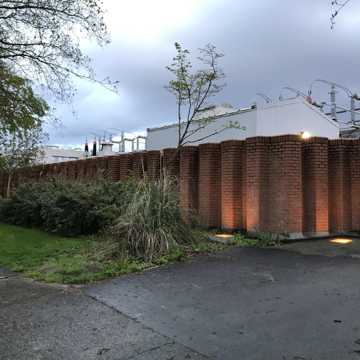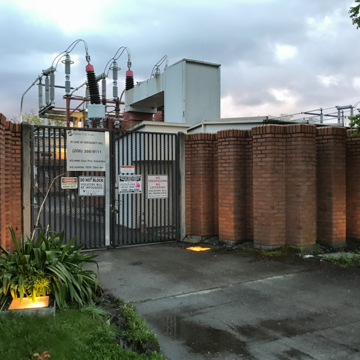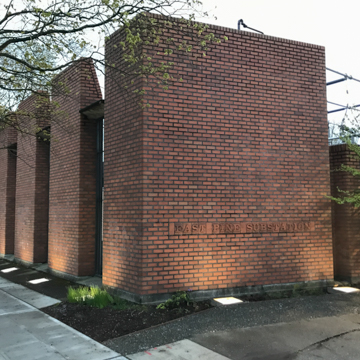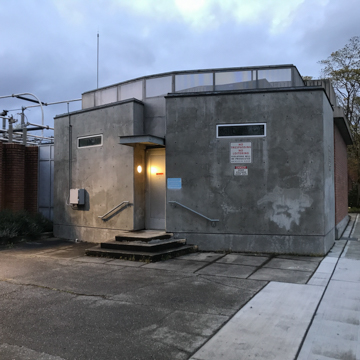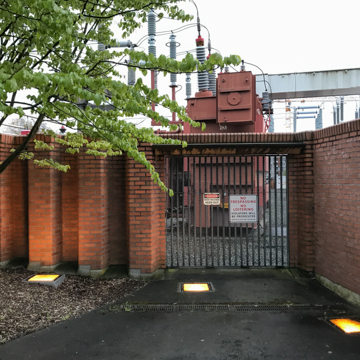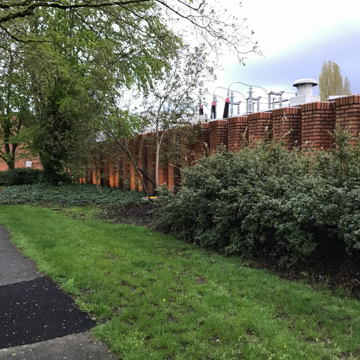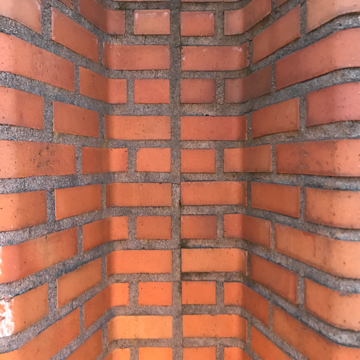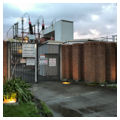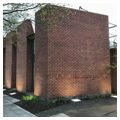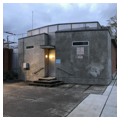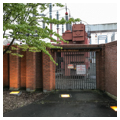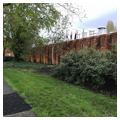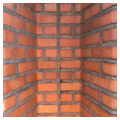In March 1965, architect Fred Bassetti appeared before the Seattle City Council to describe a new kind of public facility that he hoped to design for Seattle’s municipal power utility, Seattle City Light, in collaboration with landscape architects Richard Haag and Associates. His own firm, Fred Bassetti and Company, wanted to create a new type of electric substation, one that was not entirely inaccessible to the public, but was, instead, visible through a secure fence, and intended as an educational resource. Commenting on this unconventional effort, the Superintendent of Seattle City Light, John M. Nelson, observed that, unlike typical substations “designed to hide the electrical equipment and provide small neighborhood park areas,” the East Pine substation was “designed to play up the spectacular and dramatic appearance of the electrical equipment.”
The new East Pine Substation stands on a roughly 200 x 400–foot block bounded by 22nd and 23rd avenues, and East Pine and East Pike streets—a site that had been acquired from Puget Sound Energy, Seattle City Light’s competitor, in 1951. As completed on this 8,000-square-foot lot, the compound’s walls contained an irregular perimeter, wider at the north than the south. Bassetti rejected the typical cyclone-fenced utility compound, even one enshrouded in greenery, in favor of a facility that would be an engaging and instructive neighborhood addition.
In 1965 Seattle City Light had entered a period of growth and optimism. Abundant funds enabled the utility to undertake a variety of remarkable projects. As part of a $95 million, 6-year expansion plan, Seattle City Light constructed the Boundary Dam Hydroelectric Project in the state’s northeastern corner in October 1967, nearly 250 miles away. Completed at a cost of $44,880,000, the dam’s 265,000-horsepower turbines could supply 3,587 GW hours annually. At a time when Lady Bird Johnson encouraged highway beautification, Seattle City Light was contemplating replacing its “unsightly power line ‘jungles’” with buried high-voltage transmission and distribution lines along roadsides. The utility allocated $12.8 million for this purpose, and would spend $2 million “undergrounding” the 230,000 KW transmission lines between the Broad Street and Beacon Hill power facilities and the new East Pine Substation. Electric substations serve various functions within power grids, collecting energy, serving as circuit breaking points for safety, converting current frequency, changing electricity’s polarity (from AC to DC or vice versa), or transforming and distributing the voltage of incoming electrical power. The East Pine Substation served as a distribution substation, where high voltage power generated at the Boundary Dam was transformed to lower voltage current for everyday commercial and residential use.
Seattle City Light officials and the design team hoped to make this distribution substation something of an education center, teaching residents about the electric power grids that activated modern life. To perform this educational function safely, Bassetti ringed the equipment yard with walls ranging from 8 to 14 feet in height. Around the wall’s perimeter, the architect created a complex interplay of voids and precisely detailed brick surfaces based on the views he wished to reveal or deny. Extra-thick mortar layers exaggerated the brick bond’s solidity. For the most part, walls bordering the south side and 23rd and 22nd avenues were opaque, blocked by a corrugated line of masonry, one brick wide. (This in-and-out pattern built from a single width of brick recalls Jefferson’s serpentine walls at the University of Virginia.) Bassetti opened views near the entry gates on 22nd and 23rd avenues, as well as along the north wall, where wider brick partitions alternated with sections composed of large bronze grilles. It was on this north side that he allowed primary viewing spots. To highlight the sculptural forms of the electrical equipment, Bassetti and Company designed elegant concrete stands upon which individual pieces rested.
Other openings revealed selected views of the compound’s menagerie of switches, circuit breakers, transformers, and voltage regulators. The hexagonal control room, located just north of the 23rd Avenue main gate, had long windows enabling pedestrians to view Seattle City Light operators at work. On the open north wall, a 16-foot-high observation tower was built into the northwest corner to provide the public with deep views into the compound. According to an early newspaper report, within the tower, diagrams and other information would explain the operations of the power center. In addition, a 40 x 90–foot playground area on 22nd Avenue originally contained large switches apparently safe enough for children to handle. After 2001, the playground was removed and the observation tower closed to the public due to security concerns. Other changes within the compound were necessary as pieces of equipment wore out and were replaced over the years. In 2015, a new 30-foot-long, 22-foot-tall, 480,000-pound transformer that could resist seismic jolts more effectively was installed on a base of pendulum bearings in the equipment yard.
This complex and fanciful masonry wall recalled that of an Archaic Egyptian fortress, similar to the reconstructions of the Complex of Djoser at Saqqara (c. 2800 BCE) or the later Fortress of Senusret III at Buhen, Sudan (c. 1860 BCE). These ancient Egyptian sources had become popular in the mid-1960s. Gamel Abdul Nasser’s widely publicized Aswan High Dam project (1960–1970) was a centerpiece of his domestic program and an important symbol during the Cold War, representing Egypt’s independence from the West. The dam caused enormous environmental changes in the Nile Valley, and submerged the Buhen region when it was completed, including that of the Fortress of Senusret III, completed during Egypt’s Middle Kingdom. Prior to being submerged, British archaeologist Walter Bryan Emery began excavations of the Aswan site in 1957 and provided drawings of Senusret III’s fortress in his 1962 book, Archaic Egypt, published by Oxford University Press’s mass-market Pelican imprint. It is possible Bassetti was aware of Emery’s drawings of the Senusret III’s fortress; Bassetti’s scheme has both corrugated walls and watch towers interspersed at intervals that are comparable to those discovered during excavations.
Regardless of the architectural precedents, Bassetti’s unorthodox substation in Seattle received local and national praise. Upon its completion, it won two awards from the Washington State Chapter of the Society of Interior Decorators and another from the Northwest Brick Association. In 1968, the substation also won a National Honor Award from the American Institute of Architects and was published in the March 1968 issue of Progressive Architecture and the June issue of the AIA Journal. The following year, the AIA Northwest Regional Chapter gave it an Honor Award, as did the Seattle AIA Chapter. Attention continued in late 1971, when Art in America published an article featuring the facility.
Richard Haag assisted Bassetti on the landscaping of the East Pine Substation a few years before he began work on his magnum opus, Gas Works Park. The nature of the two projects invites comparison. In both cases, the designers called attention to the beauty of overlooked utilitarian structures. In both cases, Haag and Bassetti hoped that contemporaries would reexamine industrial artifacts, one discarded, the other new, to grasp their beauty and historical significance.
References
“Bassetti’s Electric Circus.” Progressive Architecture49, no. 3 (March 1968): 160-163.
Bonaccorso, Roberto. “Seattle Substation Upgrades Make West Coast Grid More Reliable.” Powerlines Blog, August 10, 2015. www.powerlines.seattle.gov.
“Buhen: A Dig House Becomes Home.” Egypt Exploration Society. Accessed May 22, 2017. www.ees.ac.uk.
“City Light Looks Ahead.” Seattle Times, December 3, 1965.
“City Light Substation Wins Award for Bassetti.” Seattle Times, May 26, 1968.
Haigh, John. “City Light’s ‘Operation Underground’—Phase Two.” Seattle Times, June 19, 1966.
McCue, Gerald. “Masked Ball at the Power Station," Art in America59, no. 5 (September–October 1971): 98-99.
“Open House Is Set at Power Substation.” Seattle Times, June 21 1967.
Seattle City Light. “Seattle substation upgrades make West Coast grid more reliable.” Power Lines Blog. Accessed December 26, 2015. www.powerlines.seattle.gov.
Willix, Douglas. “New Type of Substation Proposed.” Seattle Times, March 19, 1965.
“Wiring Going Underground for 6.6 Miles,” Seattle Times, June 16, 1966.














